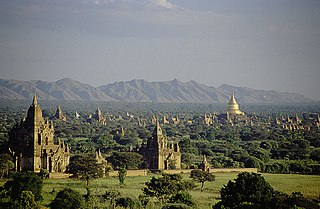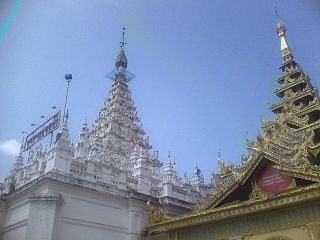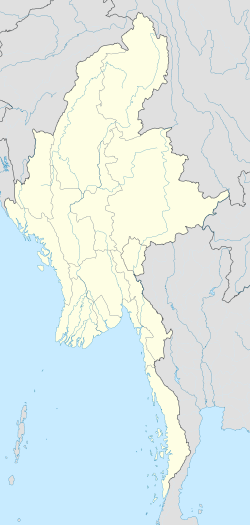
Anawrahta Minsaw was the founder of the Pagan Empire. Considered the father of the Burmese nation, Anawrahta turned a small principality in the dry zone of Upper Burma into the first Burmese Empire that formed the basis of modern-day Burma (Myanmar). Historically verifiable Burmese history begins with his accession to the Pagan throne in 1044.

Bagan is an ancient city and a UNESCO World Heritage Site in the Mandalay Region of Myanmar. From the 9th to 13th centuries, the city was the capital of the Bagan Kingdom, the first kingdom that unified the regions that would later constitute Myanmar. During the kingdom's height between the 11th and 13th centuries, more than 10,000 Buddhist temples, pagodas and monasteries were constructed in the Bagan plains alone, of which the remains of over 2200 temples and pagodas survive.

Mandalay is the second-largest city in Myanmar, after Yangon. Located on the east bank of the Irrawaddy River, 631 km north of Yangon, the city has a population of 1,225,553.

Pyay is the principal town of Pyay Township in the Bago Region in Myanmar. Pyay is located on the bank of the Irrawaddy River, 260 km (160 mi) north-west of Yangon. It is an important trade center for the Ayeyarwady Delta, Central and Upper Myanmar and the Rakhine (Arakan) State. The British Irrawaddy Flotilla Company established the current town in the late 19th century on the Irrawaddy as a transshipment point for cargo between Upper and Lower Burma. The English novelist Jane Austen's brother Rear Admiral Charles Austen died here in 1852.

Kyaukse is a town and the capital of Kyaukse District in Mandalay Region, Myanmar. Lying on the Zawgyi River, 25 miles south of Mandalay, it is served by the Mandalay-Yangon (Rangoon) railway. The first Myanmar probably settled in the area about 800, and local 12th- and 13th-century inscriptions refer to Kyaukse as “the first home”. Remains of pagodas and old cities are found throughout the area. The Shwethalyaung Pagoda, built by King Anawrahta (1044–77), is located in Kyaukse.

The nats are god-like spirits venerated in Myanmar and neighbouring countries in conjunction with Buddhism. They are divided between the 37 Great Nats who were designated that status by King Anawrahta when he formalized the official list of nats. Most of the 37 Great Nats were human beings who met violent deaths.

Mount Popa is a dormant volcano 1518 metres (4981 feet) above sea level, and located in central Myanmar in the region of Mandalay about 50 km (31 mi) southeast of Bagan (Pagan) in the Pegu Range. It can be seen from the Ayeyarwady (Irrawaddy) River as far away as 60 km (37 mi) in clear weather. Mount Popa is a pilgrimage site, with numerous Nat temples and relic sites atop the mountain.

Mandalay Hill is a 240 metres (790 ft) hill that is located to the northeast of the city centre of Mandalay in Myanmar. The city took its name from the hill. Mandalay Hill is known for its abundance of pagodas and monasteries, and has been a major pilgrimage site for Burmese Buddhists for nearly two centuries. At the top of the hill is the Sutaungpyei Pagoda. A panoramic view of Mandalay from the top of Mandalay Hill alone makes it worthwhile to attempt a climb up its stairways. There are four covered stairways called saungdan leading up the hill from the south, southeast, west and north, and convenient seats of masonry work line these stairways all the way up. A one-way motor road today saves time and also makes it accessible for those who are unable to climb up the stairs, leading to an escalator and a lift to the pagoda at the summit.

The Kingdom of Pagan was the first Burmese kingdom to unify the regions that would later constitute modern-day Myanmar. Pagan's 250-year rule over the Irrawaddy valley and its periphery laid the foundation for the ascent of Burmese language and culture, the spread of Bamar ethnicity in Upper Myanmar, and the growth of Theravada Buddhism in Myanmar and in mainland Southeast Asia.

Dance in Burma can be divided into dramatic, folk and village, and nat dances, each having distinct characteristics. Although Burmese dance resemble the traditional dancing style of its neighbors, in particular [Dance in Cambodia ], it retains unique qualities that distinguish it from other regional styles, including angular, fast-paced and energetic movements and emphasis on pose, not movement.

Chaung-U is a town located in Monywa District, Sagaing Region, Myanmar. It is the principal town of Chaung-U Township. In the Bagan Dynasty, when King Popa Saw Rahan governed the country, it was named "San Tauk Village". It was a large village where different natives of the Union of Myanmar, like Kayin, Shan and Lawah (Wah) natives, lived happily together. Then, King Kyansit founded the city, gathering ten villages together, for example, Ywa Thit and Ywa Ma, naming it Chaung-U. It is situated 231.46 feet (70.55 m) above sea level at north latitude 21° 57' and east longitude 95° 8' to 95° 25'. The Monywa–Mandalay highway road passes it, so the communication to it is good, quick and easy. The Monywa–Mandalay railway meets that of Chaung-U–Pakokku in the town's station, so it is possible to get there by train. Its official township boundary touches the boundaries of other townships: Myinmu is in the east, Myaung is in the south and south-east, Salingyi is in the west, and Monywa is in the north. The Chindwin River is in the west of the township and the town is six miles away from the river. In Chaung-U there are historical ancient pagodas. Besides, its township has other historical villages, streams, and hills.

Myitnge River (Burmese: မြစ်ငယ် or Nam Tu, also known as Dokhtawaddy River, is a major tributary of Ayeyarwady River in Myanmar. The name Myitnge in Burmese and Dokhtawaddy in Pali both mean "little river", by contrast with the Ayeyarwady or "big river".

Shwe Hpyin Nyidaw, also called Shwe Hpyin Nge or Min Lay, is one of the 37 nats in the official pantheon of Burmese nats. Together known as Shwe Hpyin Nyinaung (Brothers) or Taungbyon Min Nyinaung, he and his brother Shwe Hpyin Naungdaw were sons of Byatta, the royal messenger, and Me Wunna, a flower-eating ogress from Mount Popa, during the reign of King Anawrahta of Bagan. They were killed for neglecting their duty to provide a brick each thus leaving gaps in Taungbyone Pagoda, which was built by King Anawrahta. They are portrayed on pedestals, one lying down and the other upright with his sword shouldered arrogantly. Me Wunna died of a broken heart after Byatta was killed and later their sons were taken away on the king's orders. She became a nat known as Popa Medaw.

Saw Mon Hla was a principal queen of King Anawrahta of Pagan. She is known in Burmese history for her beauty and her eventual exile instigated by other rival queens. Her story is still part of popular Burmese theater, and she is portrayed as a sad romantic figure.

Pagoda festivals are regular festivals found throughout Myanmar that commemorate major religious events in pagoda's history, including the founding of a pagoda and the crowning of the pagoda's hti (umbrella). Pagoda festivals are dictated by the Burmese religious calendar and often are held several days at a time. Major events in a pagoda festival typically do not coincide with Uposatha days, during which pious Buddhists observe the Eight Precepts. The majority of pagoda festivals are held during the dry season, from the months of Tazaungmon (November) to Tabaung (March). During the full moon day of Tabaung, Buddhist devotees in various parts of Myanmar also celebrate sand pagoda festivals.

Shwebo is a city in Sagaing Region, Burma, 110 km north-west of Mandalay between the Irrawaddy and the Mu rivers. The city was the origin of the Konbaung Dynasty, established by King Alaungpaya in 1752, that was the dominant political force in Burma after the mid-18th century. It served as Alaungpaya's capital from 1752 to 1760. As of 2021, it has a population of 88,914.
The architecture of Myanmar, in Southeast Asia, includes architectural styles which reflect the influence of neighboring and Western nations and modernization. The country's most prominent buildings include Buddhist pagodas, stupas and temples, British colonial buildings, and modern renovations and structures. Myanmar's traditional architecture is primarily used for worship, pilgrimage, storage of Buddhist relics, political activism and tourism.

The Taungbyone Festival is one of the most well-known festivals among the people of Myanmar, held annually in honour of the Taungbyon nat brothers or the two brothers of Taungbyone village. Actually it is the festival of the two pagodas, by the name of Sutaungpyae built by King Anawrahta and the later-built Sutaungya. The pagodas' festival is designated to be celebrated for two days, from the eighth waxing day to the tenth of the Burmese month of Wagaung. At the same time, the nat festival is held alongside that of the pagodas.

The Tamote Shinpin Shwegugyi Temple is a Buddhist temple in Kyaukse, Mandalay Region, Myanmar. It was originally built by King Anawrahta of Pagan, and the second storey added by King Narapatisithu, and both were encased inside a huge stupa built by King Uzana of the Pinya dynasty. It was one of nine pagodas outside the ancient city that denoted the extent of the Bagan Empire. The temple had a pagoda on top was discovered to be hiding another pagoda inside, which in turn encased a two-storey temple.

Shwethalyaung Pagoda is a Buddhist temple in Kyaukse, Mandalay Region, Myanmar. It is located on top of the Shwethalyaung Hill. The pagoda was built by King Anawrahta of Bagan and enshrined the replica of the Buddha's teeth.




















